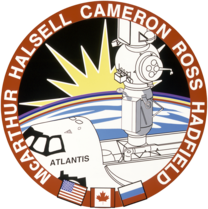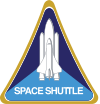STS-74
| Missionsemblem | |||||
|---|---|---|---|---|---|
 | |||||
| Missionsstatistik | |||||
| Missionsnavn: | STS-74 | ||||
| Rumagentur: | NASA | ||||
| Rumfærge: | Atlantis (15) | ||||
| Antal besætningsmedlemmer: | 5 | ||||
| Affyringsrampe: | LC-39A (KSC) | ||||
| Opsendelse: | 12 november 1995 | ||||
| Landing: | 22 november 1995 | ||||
| Landet på: | KSC | ||||
| Varighed: | 8 døgn og 5 timer | ||||
| Foto af besætningen | |||||
 | |||||
| Navigation | |||||
| |||||
STS-74 (Space Transportation System-74) var Atlantis 15. rumfærge-mission. Opsendt 12 november 1995 og vendte tilbage den 12 november 1995. Det var den anden mission hvor en NASA rumfærge blev sammenkoblet med den russiske rumstation MIR.
Missionen var rumfærgernes fjerde flyvning til rumstationen Mir, de tidligere var STS-60 STS-63, STS-71 og Sojuz TM-21. Efterfølgende fælles missioner til Mir: STS-76, STS-79, STS-81, STS-84, STS-86, STS-89 og STS-91.
Besætning

 Kenneth Cameron (kaptajn)
Kenneth Cameron (kaptajn)
 James Halsell (pilot)
James Halsell (pilot)
 Chris Hadfield (missionsspecialist)
Chris Hadfield (missionsspecialist)
 Jerry Ross (missionsspecialist)
Jerry Ross (missionsspecialist)
 William McArthur (missionsspecialist)
William McArthur (missionsspecialist)
Missionen
Rumfærgen medbragte Mir Docking Module, et system til sammenkobling mellem rumfærgen og MIR.
| Wikimedia Commons har medier relateret til: |
Eksterne henvisninger
- STS-74 NASA (engelsk)
- STS-74 Arkiveret 20. december 2016 hos Wayback Machine NASA KSC (engelsk)
| ||||||||||||||||||||
| ||||||||
Medier brugt på denne side
Flag of Canada introduced in 1965, using Pantone colors. This design replaced the Canadian Red Ensign design.
This image of the Russian space station Mir was photographed by a crewmember of the STS-74 mission when the Space Shuttle Atlantis was approaching Mir for docking. STS-74 was the second Shuttle-Mir docking mission, during which the Docking Module was delivered and installed, making it possible for Space Shuttles to dock more easily with the station. Atlantis delivered water, supplies, and equipment, including two new solar arrays to upgrade Mir, and returned to Earth with experiment samples, equipment for repair and analysis, and products manufactured on the station. STS-74 was launched on 12 November 1995, and landed at the Kennedy Space Centre on 20 November 1995.
The crew patch of STS-73, the second flight of the United States Microgravity Laboratory (USML-2), depicts the Space Shuttle Columbia in the vastness of space. In the foreground are the classic regular polyhedrons that were investigated by Plato and later Euclid. The Pythagoreans were also fascinated by the symmetrical three-dimensional objects whose sides are the same regular polygon. The tetrahedron, the cube, the octahedron, and the icosahedron were each associated with the Natural Elements of that time: fire (on this mission represented as combustion science); Earth (crystallography), air and water (fluid physics). An additional icon shown as the infinity symbol was added to further convey the discipline of fluid mechanics. The shape of the emblem represents a fifth polyhedron, a dodecahedron, which the Pythagoreans thought corresponded to a fifth element that represented the cosmos.
SVG version of PNG Space Shuttle Logo/Patch.
Space Shuttle Atlantis - A view of the new en:Mir Docking Module, positioned in Atlantis 's payload bay on en:STS-74, ready to be docked to the Space Station.
Image has been cropped from original.
Space Shuttle Atlantis takes flight on its STS-27 mission on December 2, 1988, 9:30 a.m. EST, utilizing 375,000 pounds thrust produced by its three main engines. The STS-27 was the third classified mission dedicated to the Department of Defense (DoD). After completion of mission, Orbiter Atlantis landed December 6, 1988, 3:36 p.m. PST at Edwards Air Force Base, California.
STS-74 Mission Insignia
- The STS-74 crew patch depicts the orbiter Atlantis docked to the Russian Space Station Mir. The central focus is on the Russian-built docking module, drawn with shading to accentuate its pivotal importance to both STS-74 and the NASA-Mir Program. The rainbow across the horizon represents the Earth's atmosphere, the thin membrane protecting all nations, while the three flags across the bottom show those nations participating in STS-74: Russia, Canada, and the United States. The sunrise is symbolic of the dawn of a new era in NASA space flight , that of International Space Station construction.
The crew assigned to the STS-74 mission included (seated left to right) James D. Halsell, pilot and Kenneth D. Cameron, commander. Standing, left to right, are mission specialists William S. McArthur, Jerry L. Ross, and Chris A. Hadfield. Launched aboard the Space Shuttle Atlantis on November 12, 1995 at 7:30:43.071 am (EST), the STS-74 mission performed the second docking of a U.S. Space Shuttle to the Russian Space Station Mir, continuing Phase I activities leading to the construction of the International Space Station (ISS).
Space Station Mir - View of Atlantis taken from the Base Block module of Mir with the station's solar arrays and Atlantis's payload bay visible.
Forfatter/Opretter: Kwamikagami, Licens: CC BY-SA 4.0
symbol of Mars. 16 × 16 pixel nominal dimensions, lines 2 pixel thick, square caps. Colour 75% blue: red=0 green=0 blue=191 (#0000BF).
STS-72 Mission Insignia

















